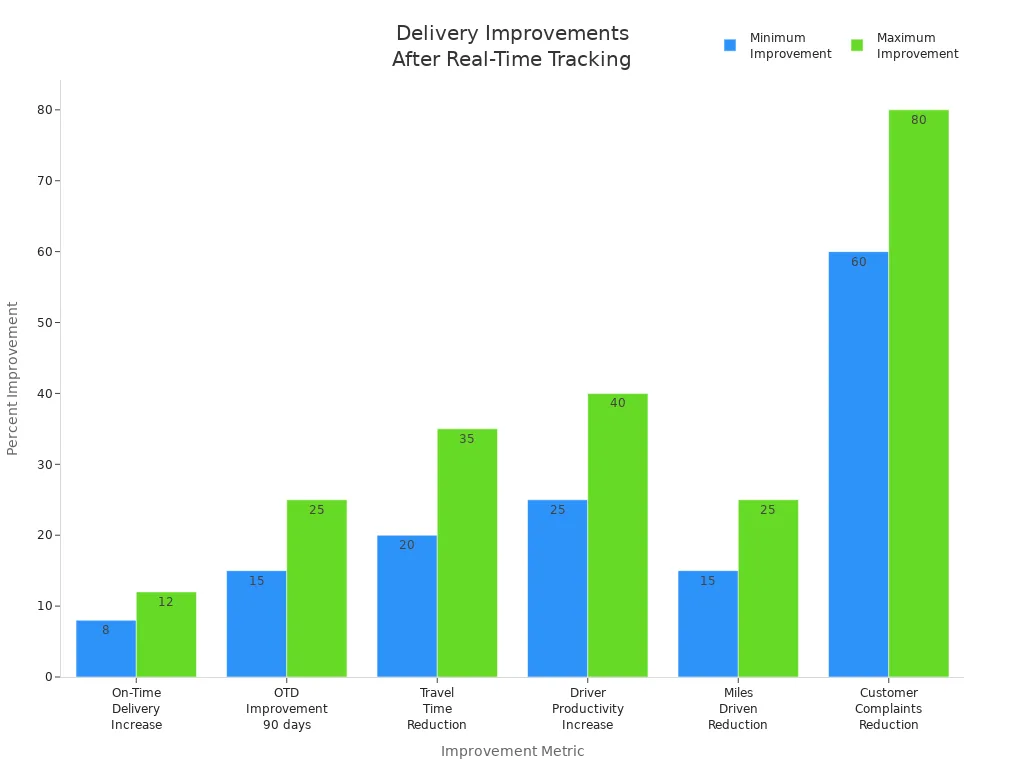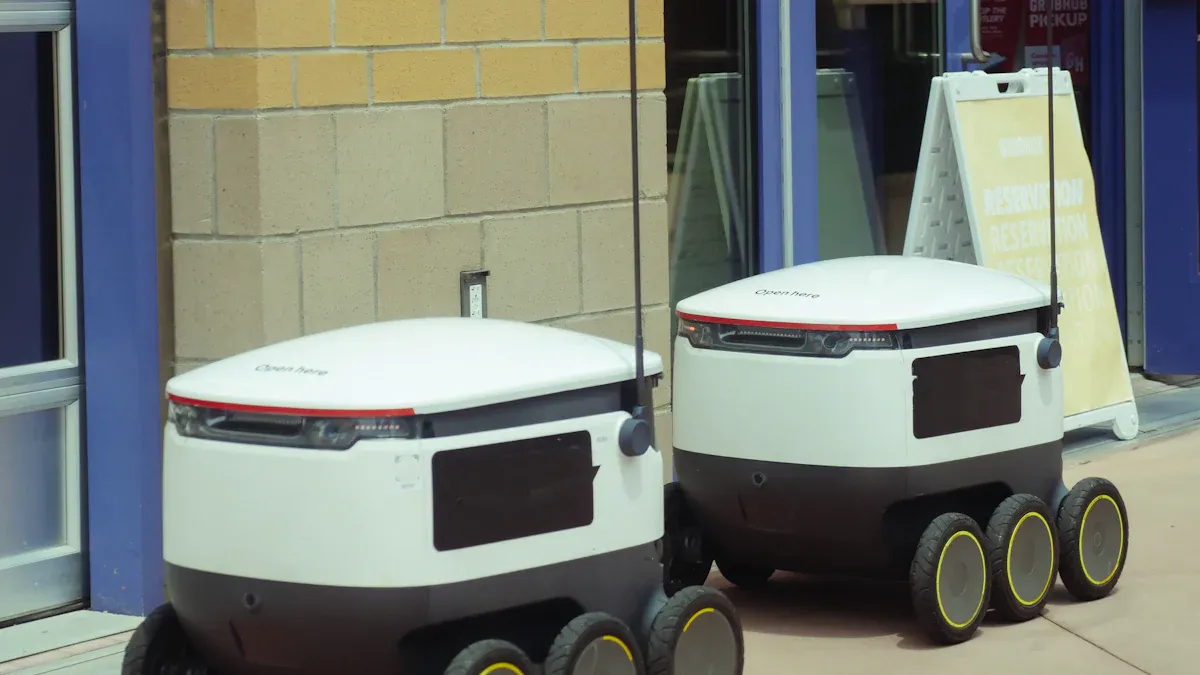Five Proven Strategies for Successful Logistics Tracking

What are the five proven strategies for successful logistics tracking? You need ways that help work faster, save money, and make customers happy.
Real-time tracking lets customers see delivery updates. It helps build trust. It also lowers support costs.
Automation helps lower work costs by 20%.
Platforms like JUSDA make logistics management easier and smarter. Check your logistics plan. New ideas can make things much better.
Key Takeaways
Use real-time tracking to watch shipments right away. This helps stop delays. It keeps customers updated and pleased.
Use data analytics and automation to make better logistics choices. This saves money. It makes things move faster.
Work together with others in the supply chain. Set up real-time alerts to fix problems fast. This helps deliveries stay on time.
Real-Time Tracking Systems

JUSDA’s Technology Integration
You want to know where your shipments are right now. Real-time tracking lets you do this. JUSDA’s JusLink platform uses GPS, RFID, and IoT sensors. These tools tell you the location, speed, and temperature of your goods. Cloud computing and big data help these tools work together. You get updates right away. It does not matter if your goods are on a truck, in a warehouse, or at the border. JusLink links with carrier and customs data. You can see every part of the trip. This system helps you find delays early. You can fix problems quickly.
Here is a simple table of tracking technologies:
Technology | Main Use in Logistics Tracking |
|---|---|
GPS | Tracks vehicles and shipments |
RFID | Manages inventory in warehouses |
IoT Sensors | Monitors conditions like temperature |
Cloud Platforms | Shares real-time data across the supply chain |
Mobile Apps | Lets you track and manage shipments remotely |
Benefits for Logistics Tracking
Real-time tracking gives you more control. You can act fast when things change. This helps you avoid surprises. JusLink’s AI features make brokerage tasks faster by 40%. This means there are fewer delays. You can send shipments a new way if there is traffic or bad weather. Customers like getting updates. Most people, about 88%, want to see their order status live. Companies using real-time tracking have up to 60% more on-time deliveries. There are fewer complaints and the supply chain works better.

You make tracking better, save money, and keep customers happy. Real-time tracking helps you stay ahead in logistics tracking.
Data-Driven Logistics Management
Analytics for Effective Logistics Management
You want your logistics plan to be smart and quick. Data analytics helps you do this. Analytics shows you patterns in your supply chain. You can find problems before they get worse. About 75% of logistics companies use AI-driven analytics now. This makes their logistics management better. You can make good choices every day.
Here’s how analytics helps with logistics management:
You can guess demand by checking more than old sales. This helps you get ready for busy times.
You manage inventory better by watching turnover and restocking. This lowers waste and saves money.
Real-time data from sensors lets you change shipment routes or fix things before they break.
You can look at supplier performance and choose the best ones.
Analytics helps you see what customers like and offer flexible delivery.
Predictive analytics warns you about risks, like bad weather, so you can plan ahead.
You measure how well things work with KPIs like on-time delivery and transport costs.
Tip: Use analytics to find slow spots in your logistics process. This helps you keep improving and save money.
JUSDA’s Collaboration Platform
JUSDA’s Supply Chain Management Collaboration Platform puts all your logistics planning in one place. It uses AI, big data, and predictive analytics for real-time updates. You can connect data from GPS, IoT sensors, and RFID. This makes your logistics system smarter and more trustworthy.
Key metrics you should watch include:
KPI Category | |
|---|---|
Operational | On-time delivery rates, Inventory turnover |
Financial | Transportation costs, Warehousing expenses |
Customer-focused | Customer satisfaction, Order fulfillment rates |
With JUSDA, you get insights from data that help you pick better routes, balance inventory, and spend less. You can build a strong logistics plan, improve your processes, and reach your cost-saving goals. This is how you get good logistics and stay ahead in your field.
Automation in Logistics Tracking

JUSDA’s Process Automation
You want your logistics system to work well and have fewer mistakes. Automation helps make this happen. Automated tools take away manual data entry. This means there are fewer human errors. JUSDA uses smart warehousing with robots, sensors, and AI-powered scanning. These tools track inventory right away. Lights or robots help workers pick and pack items faster and better. JUSDA’s K2L process automation links every step, from order to delivery, with digital workflows. You also get easy connections with ERP, TMS, and WMS systems. Your data moves fast and safely between platforms. Everyone can see the same information.
Here are some common automation tools you might use:
Automated Guided Vehicles (AGVs) move goods safely.
Pick-and-place robots help with packaging and inventory.
AI software guesses demand and plans routes.
Barcode and RFID tech collect data right away.
Note: Automation lets you find problems early and keeps orders correct.
Efficiency and Cost Reduction
Automation makes logistics more efficient. Smart warehousing helps packing and shipping go faster. IoT sensors give real-time data for quick choices. You save time and use fewer resources. JUSDA’s automated systems help stop costly mistakes, like sending the wrong item or running out of stock. Companies using automation lower labor costs by up to 30%. Amazon cut labor costs by 20% per unit with robots. Automation also raises productivity. You can handle more orders without hiring more people. This is real cost optimization.
Automation Benefit | Impact on Operations |
|---|---|
Fewer manual errors | More accurate orders |
Faster order processing | Quicker delivery times |
Lower labor costs | Higher profit margins |
Better inventory control | Less waste and shortages |
Your logistics process gets faster, smarter, and ready to grow.
Supply Chain Collaboration
JUSDA’s Integrated Solutions
Working together makes things easier for everyone. In logistics management, suppliers, customers, and managers must share information. When people share real-time data, results get better. JUSDA’s collaboration platform links all parts of your supply chain. You can see sales, inventory, and delivery status in one place. This helps you make smart choices for your logistics strategy and logistics planning.
Here’s what you get when you use supply chain collaboration:
Key Benefit | Explanation |
|---|---|
Sharing sales and inventory data helps you guess demand better. You avoid running out or having too much. | |
Faster Response to Market Changes | Real-time data helps you react fast to what customers want. You can change your logistics strategy quickly. |
Optimized Transportation and Inventory | You plan routes and warehouse space together. This lowers costs and makes logistics planning easier. |
Enhanced Customer Service | You fix problems faster and give better updates to customers. This builds trust and loyalty. |
JUSDA’s platform uses AI and cloud technology to help share data. You get updates right away, so you always know what is happening. This makes your logistics management more correct and much faster.
Enhancing Logistics Management
Using a platform like JUSDA’s helps everyone see the same data. There are no surprises. You can track shipments, check inventory, and see delivery times in real time. This helps you find problems early and fix them before they get bigger.
You also get clear jobs and goals for your team. Everyone knows what to do and how to check success. Better communication helps you avoid mistakes and keep your logistics strategy working well. Real-time data sharing lets you change routes or plans fast if something goes wrong. This keeps your logistics planning strong and flexible.
Tip: Connecting your systems and sharing data makes logistics management smarter and more reliable. You save time, spend less money, and keep customers happy.
Proactive Exception Management
Real-Time Alerts with JUSDA
Things can go wrong in logistics. Packages might get lost. Trucks can break down. Sometimes labels are wrong. If you wait to fix problems, you lose time and money. Proactive exception management helps you find issues early. You can act fast. JUSDA’s digital platforms send real-time alerts and notifications. You get updates on your phone, email, or app. This means you can respond right away, wherever you are.
Here’s why real-time alerts help:
You spot problems like missed drop-offs or damaged goods fast.
Automated alerts let you fix things before they get worse.
You save time because you don’t need manual checks.
Notifications keep your team and customers updated.
You build trust by caring about every shipment.
JUSDA uses AI to guess delivery times and find risks. The system checks data from GPS, IoT sensors, and weather reports. If something changes, you get an instant update. You can reroute trucks or call for help. This keeps your supply chain moving.
Minimizing Disruptions
You want deliveries to arrive on time. Real-time alerts help you avoid delays. If a truck gets stuck or a storm happens, JUSDA’s platform sends a message to everyone. You can reroute shipments, send help, or notify customers in minutes. This keeps your operations smooth and customers happy.
JUSDA’s AI-powered system updates ETAs as things change. It uses real-time data to make smart choices. You get fewer surprises and more control. Proactive exception management means you solve problems before they grow. You protect your brand, save money, and keep your logistics strong.
Benefit of Exception Management | How It Helps You |
|---|---|
Faster problem detection | Less downtime |
Automated alerts | Quick response |
Dynamic ETA predictions | Accurate delivery times |
Risk management | Fewer costly mistakes |
Better customer experience | More trust and satisfaction |
Tip: Set up real-time alerts and use AI tools like JUSDA’s platform. You’ll catch problems early and keep your supply chain on track.

JUSDA Solutions
To provide you with professional solutions and quotations.
You can make logistics tracking better with five main strategies. These are better training, automation, system integration, smart data analytics, and using new ideas. JUSDA’s platforms help you spend less, work quicker, and keep customers pleased. Set clear goals, like making deliveries faster and lowering costs. > Tip: Always look for new ways to make your logistics management better.
See Also
Discover Five Cutting-Edge Ways To Optimize Supply Chains
Best Proven Techniques To Ensure Supply Chain Success
Mastering Lean Logistics Strategies In Advanced Manufacturing
Unlock Hidden Logistics Tips To Boost Supply Chain Savings
How Robotics Revolutionize Warehouse Efficiency And Productivity
